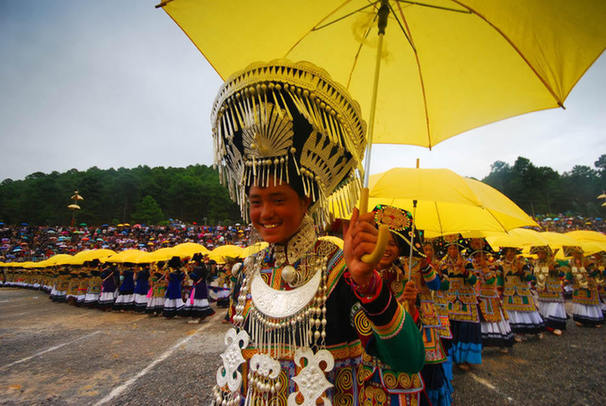Land of Moon, Mother and Matriarchy
Land of Moon, Mother and Matriarchy
By staff reporter JIAO FENG & AI JIE
|
 |
|
Hundreds of girls in the circular formations of the traditional dance performed at the Torch Festival of the Yi minority. |
XICHANG City, also known as "Moon City," reflects both the romance and the space-age connotations of the nickname it has earned. This capital of Liangshan Yi Autonomous Prefecture in Sichuan Province, is situated in southwestern China, and is considered a seat of old culture with more than 2,000 years of history. Xichang City is also renowned in the world for Xichang Satellite Launch Center.
For its low latitude, high altitude and less cloud and fog, Xichang residents have the luck to observe a bigger, rounder and brighter moon than other places in China. The higher air transparency here is due to less air pollution and little suspended matter in its skies. At 1,500 meters above sea level, Xichang sees very modest changes in temperature across the seasons, and enjoys an annual mean temperature of 18OC, making it a pleasant place to visit year round.
Liangshan Prefecture has the largest concentration of Yi minority people living in compact communities. Its Torch Festival is the most grand traditional festival staged by this ethnic group, with the richest cultural content, greatest number of participants and the most distinctive ethnic flavors. On the 24th day of the sixth lunar month (usually in July of the Gregorian calendar), people of the Yi minority dress in their splendid costumes and sing and dance with joyous abandon. A very popular beauty contest for both male and female youth is also held on this day along with other kinds of competitions like best costume, horse races, wrestling matches and archery contests. At night, the torches are lit, the parade commences and the heartfelt celebration of their culture begins. The Liangshan International Torch Festival debuted here in the 1980s, and has since become a famed brand event for displaying the culture of the Yi minority.
A multitude of domestic and foreign tourists are also drawn to Xichang City's picturesque natural landscapes, historical relic collection and unique ethnic customs.
Torch Festival
Torch Festival, pronounced as dou ze in the Yi language, implies "offering sacrifice to fire," and like most festivals many legends surround it. The celebration is essentially an ancient worship of fire. The Yi minority people regard fire as an incarnation of a deity, a source of prosperity and wealth, and a symbol of purity and happiness.
In the fifth lunar month, one month prior to the Torch Festival, people begin their preparations. Two things are essential. One is the preparation of sacrifices, usually various kinds of meat, and the other is the creation of costumes. Each girl of the Yi minority needs to prepare a headscarf, a colorful coat and skirt and other accessories, with some girls even making a dress, a belt and a floral sachet for their lovers. Young men practice wrestling and equestrian skills, and purchase various silver ornaments for their valentines. Small groups of young girls are often seen sitting together to teach each other how to play the harmonica, and rehearse their singing and dancing. The elders begin wandering from village to village, door to door, to select bulls and goats for fighting contests. Led by their parents, children cut bamboo and grass to truss into bundles and expose to strong sunshine for several days; these are fashioned into torches. When completely dry, these torches will be stored in places where moisture cannot spoil them.
The traditional event usually lasts for three days. The first day is devoted to the sacrificial rite for fire. The Yi people dressed in splendid costumes arrange banquets to offer the deity various kinds of meat and liquor, and pray for kind weather and good fortune for their families. Once the banquet is over and night falling, the torch-lighting ritual begins. Youngsters each have a naturally-prepared torch, which is lit in their house, and then they circle the house one to three times. Next they head for the family fields, and circle the croplands to drive out evil spirits. Kids also join the parade, holding their torches aloft, and finally converge at the place where many villages congregate for an evening of exceptionally boisterous singing and dancing.
On the second day people gather around the altar of the sacred fire. Various traditional festive activities include cheering on the young men competing in the races and wrestling matches, or watching bull, goat and cock fighting. Dressed in their beautiful attire, girls open their yellow umbrellas and begin their singing and dancing routines. The show goes on, rain or shine, and women open their yellow umbrellas for either weather condition. The most important event in the day is the beauty contest. Custom requires the elders select the most handsome boy and pretty girl. As night falls, young lovers steal away into the mountains or to river banks, whispering sweet nothings under their umbrellas, and playing the harmonica and yueqin (a four-stringed plucked instrument). No wonder the torch festival has become known as a lovers' songfest.
Services
Economy
- Eco-agriculture and Eco-tourism Power Nanchang’s Green Development
- Balance Environmental Protection and Economic Prosperity – Nanchang Looks to European Technology for Green Development
- Sustainable Growth Requires Wiser Energy Use
- Chinese Economy: On the Path of Scientific Development
- China's Economy over the Last Ten Years

